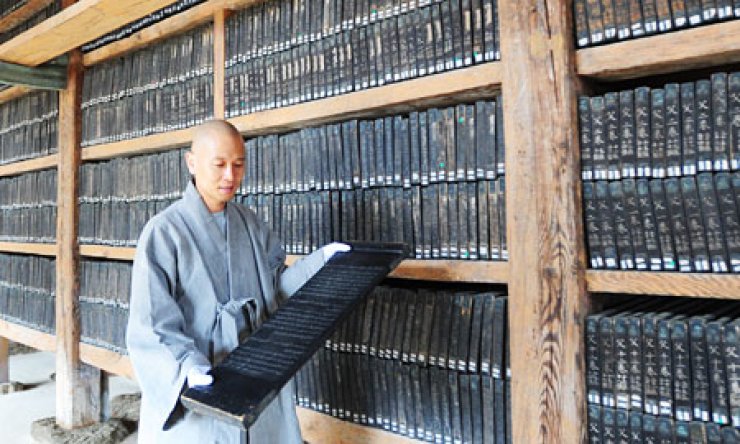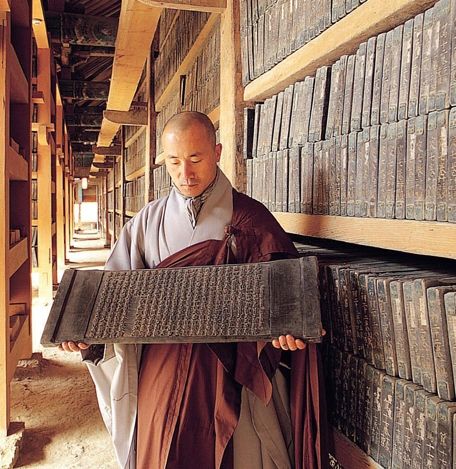The Tripiṭaka Koreana or Palman Daejanggyeong ("Eighty-Thousand Tripiṭaka") is a Korean collection of the Tripiṭaka (Buddhist scriptures), carved onto 81,258 wooden printing blocks in the 13th century. 1/ 

It is the world's most comprehensive and oldest intact version of Buddhist canon in Hanja script, with no known errors or errata in the 52,330,152 characters which are organized in over 1496 titles and 6568 volumes. 2/ 

Each wood block measures 24 centimeters in height and 70 centimeters in length. The thickness of the blocks ranges from 2.6 to 4 centimeters and each weighs about three to four kilograms. 3/ 

The woodblocks would form a pile 2.74 km high if stacked, measure 60 km long when lined up, and weigh 280 tons in total. The woodblocks are in pristine condition without warping or deformation despite being created more than 750 years ago. 4/
The Tripiṭaka Koreana is stored in Haeinsa, a Buddhist temple in South Gyeongsang Province, in South Korea. 5/ 

The Tripiṭaka Koreana should more accurately be named the Korean Buddhist Canon, because it's much greater in scale than the actual Tripiṭaka, and includes much additional content such as travelogues, Sanskrit and Chinese dictionaries, and biographies of monks and nuns. 6/ 

The Tripiṭaka Koreana was designated a National Treasure of South Korea in 1962, and inscribed in the UNESCO Memory of the World Register in 2007. It's importance to the Korean people is incalculable - it's an integral part of the national cultural identity. 7/
Work on the first Tripiṭaka Koreana began in 1011 during the Goryeo–Khitan War and was completed in 1087. The act of carving the 6000 woodblocks was considered to be a way of bringing about a change in fortune by invoking the Buddha's help. 8/ 

This original set of woodblocks was destroyed by fire during the Mongol invasions of Korea in 1232, although scattered volumes printed from these blocks still remain - an example is shown here. 9/ 





To once again implore divine assistance with combating the Mongol threat, King Gojong ordered the revision and re-creation of the Tripiṭaka. The carving began in 1237 and was completed in 12 years, involving monks from both the Seon and Gyo schools. 10/
This second version is usually what is meant by the Tripiṭaka Koreana today. In 1398, it was moved to the Buddhist temple at Haeinsa, where it has remained housed in four purpose built buildings. 11/ 

The production of the Tripiṭaka Koreana was an enormous national commitment of money and manpower, perhaps comparable to the US missions to the Moon in the 1960s. Thousands of scholars and craftsmen were employed in this massive project. 12/ 

The historical value of the Tripiṭaka Koreana comes from the fact that it is the most complete and accurate extant collection of Buddhist treatises, laws, and scriptures. The compilers of the Korean version incorporated older Northern Song Chinese. & Khitan versions. 13/
The quality of the wood blocks is attributed to Sugi, the Buddhist monk in charge of the project, who carefully checked the Korean version for errors. Upon completing the Tripiṭaka Koreana, Sugi published 30 volumes of Additional Records which recorded errors, and omissions. 14/ 



Because of the supreme accuracy of the Tripiṭaka Koreana, the Japanese, Chinese, and Taiwanese versions of the Tripiṭaka are all based on this Korean version. 15/
The Tripiṭaka Koreana was one of the most coveted items among Japanese Buddhists in the Edo period. Japan never managed to create a woodblock Tripiṭaka, and made constant requests and attempts to acquire the Tripiṭaka Koreana from Korea since 1388. 16/ 

45 complete printings of the Tripiṭaka Koreana were given to Japan since the Muromachi period, mostly as diplomatic gifts, and sometimes under duress. The Tripiṭaka Koreana was used as the basis for the modern Japanese Taishō Tripiṭaka. 17/
Each block was made of birch wood from the southern islands of Korea and treated to prevent the decay of the wood. The blocks were soaked in sea water for three years, then cut and then boiled in salt water. 18/ 

Next, the blocks were placed in the shade and exposed to the wind for three years, at which point they were finally ready to be carved. After each block was carved, it was covered in a poisonous lacquer to keep insects away and then framed with metal to prevent warping. 19/
Every block was inscribed with 23 lines of text with 14 characters per line. Therefore, each block, counting both sides, contained a total of 644 characters. The earliest printings from the woodblocks were kept in scroll format; most of these have not survived. 20/ 

In 1914-5, three sets of the entire Tripataka Koreana were printed, of which two went to Japan. One survives in the Imperial Household in Tokyo. The other set was apparently lost in the Great Kanto Earthquake of 1923. The whereabouts of the third set, is unknown. 21/
During the 1914-15 printing project, a few parts were separately “off-printed.” and this four-volume work is such an example. Another set of this text, which belonged to Naito Konan (1866-1934), the Japanese historian and Sinologist is now held by Kansai University in Osaka. 22/ 



• • •
Missing some Tweet in this thread? You can try to
force a refresh


















